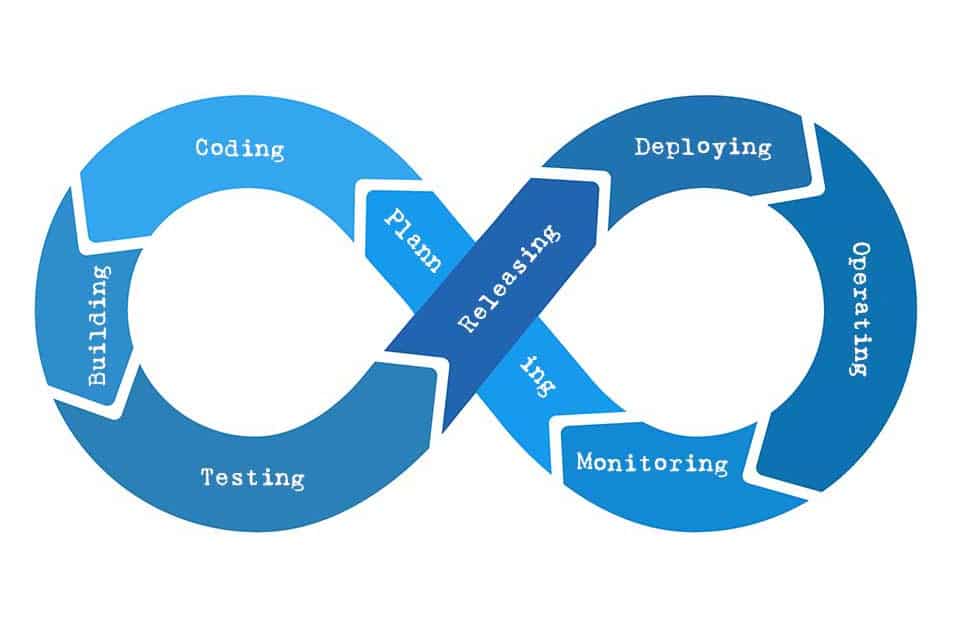What is Continuous Delivery?
Table of Contents: Definition – Process – Advantages – Challenges – Tips – Tools – Notes
Smartpedia: The term Continuous Delivery stands for a collection of techniques, processes and tools that enable the constant flow of a software delivery.
Continuous Delivery – the Perfection of Software Delivery
Continuous Delivery describes the turning away of a classical software development with the stages of development, quality assurance and delivery, which usually occur only once in each release. The term stands for a collection of techniques, processes and tools that enable the ongoing deployment of software in short time intervals. Continuous delivery is made possible by a largely automated pipeline – also known as a Continuous Delivery Pipeline or Continuous Deployment Pipeline.
In the Agile Manifesto, the first principle is: “The highest priority is to satisfy customers through early and continuous delivery of valuable software”. This principle is the foundation of Continuous Delivery.
The Continuous Delivery Process
The goal of Continuous Delivery is to shorten the release time of product versions. In many organisations, it often takes months before current software versions can be delivered. There are delays, downtime and waiting times, as well as build, testing and deployment difficulties. To shorten the build-test-release cycle, the quality of each step must be improved:
- Planning the next iteration or sprint (Planning)
- Implementation of new functions (Coding)
- Creation of a new version (Building)
- Automated testing of the new version (Testing)
- Release of the new version (Releasing)
- Automated distribution of the new version (Deploying)
- Operation of the new version (Operating)
- Automated control of the new version (monitoring)
The following steps – initiated by the versioning of a source code file – usually run in detail:
- A Continuous Integration Server performs module tests, generates a build, and delivers it to a test environment.
- Various tests are performed in the test environment:
Unit tests check individual components and their functions. If this first test stage – also called Commit Stage – was successful, the Acceptance Test Stage follows with integration, acceptance and system tests (e.g. also load and performance tests).
As soon as errors are detected within the test environment, the pipeline is interrupted and the developer receives a notification. - Often the tests are completed by manual, explorative tests.
- If all tests are passed, the software is released and delivered to production and/or customers.
Advantages of Continuous Delivery
In the course of continuous delivery, it is sometimes argued that the quality suffers due to the fast timing of the software delivery, as stability and reliability decrease. If organisations take the trouble to set up targeted continuous delivery pipelines, the opposite is often the case in practice. Continuous Delivery can offer a number of advantages:
- Time-to-market is improved because automated testing and automatic build saves a lot of time.
- The quality increases because developers can concentrate on explorative or usability tests.
- The products become better, because the continuous delivery of small innovations promotes feedback from users. If necessary, users can test ideas before whole functions are developed. This leads to more acceptance by customers and consequently to better products. At the same time, the risk of undesirable developments also decreases.
In combination with agile methods, Continuous Delivery offers the fast, reliable and repeatable delivery of software. On the other hand, there is an initial effort for setting up the Continuous Delivery Pipeline as well as the effort for maintenance and further development of the systems.
Challenges with Continuous Delivery
Continuous Delivery offers benefits, but there are also some challenges that can arise when implementing and maintaining it:
- Modern applications can have very complex infrastructures that are difficult to automate, test and manage.
- Automation and continuous deployment of changes can raise security concerns. Therefore, it makes sense to regularly check the implementation for security vulnerabilities.
- The introduction of Continuous Delivery often changes the collaboration between development and operations, which may trigger resistance.
- Additional resources are almost certainly needed for automation and training/education of the teams.
- Choosing the right tools and technologies for automation and delivery can be difficult. There are many options, and not all of them fit every organisation. In addition, it is important to have effective error management strategies in place to quickly identify and fix problems and learn from mistakes.
- As an organisation grows, processes and pipelines may need to be adapted and scaled. This requires careful planning and coordination.
Last but not least, some industries have strict regulatory requirements. Continuous Delivery has to be in line with corresponding requirements, which can bring additional challenges.
Tips for Continuous Delivery
What are the tips for introducing and using Continuous Delivery?
- When introducing it is important to consider the psychological impact on your development team. The constant change and the need to react quickly to problems can lead to stress. Make sure you allocate resources to support and make your team members feel comfortable. A positive attitude towards change and continuous improvement is crucial.
- Continuous Delivery can be implemented with a variety of tools and technologies. Rather than focusing solely on tool selection, keep in mind the overall value to your organisation. Ask yourself how it can help achieve your organisation’s business goals. This may lead you to select specific tools and approaches that best fit your individual needs, rather than simply following trends.
- Invest time and resources in automating tests, builds, deployments and other repeatable tasks. This can minimise human error and increase speed.
- Continuous Delivery requires a robust testing strategy. Automate these tests to ensure changes get into production without issues. Also, use feature flags; they allow new features to be enabled or disabled in the production environment without having to redeploy code. This facilitates the phased rollout of new features and the rollback of changes in case of problems.
- Foster a DevOps culture in your organisation where teams work closely together to improve the efficiency and quality of deployment. This may require training and cultural changes.
Remember that Continuous Delivery requires continuous improvement. Collect feedback, analyse metrics and adjust your processes accordingly to continuously improve. It is important that the entire team understands and supports the benefits of Continuous Delivery to be successful.
Continuous Delivery Tools
Continuous Delivery tools aim to automate the software development process from code submission to deployment. They typically provide a set of tools and processes for building and testing software, including Continuous Integration, Continuous Testing and Continuous Deployment:
Continuous Integration tools automatically build and test the software each time code changes are committed to the repository to ensure that all code changes are properly tested before deployment.
Continuous Testing tools help automate the testing process and enable teams to quickly recognise bugs and issues in the code.
Continuous Deployment tools automate the process of deploying software to production, enabling teams to release new software features quickly and reliably.
Here is a small selection with Continuous Delivery (CD) tools:
You can easily find many other solutions on the internet.
Notes:
Feel free to share or link to the content on this page.
[1] In the course of Continuous Delivery, the term Continuous Integration is often used. Together, the two are often abbreviated as CI/CD, although this abbreviation should not be confused with the marketing abbreviation of the same name, which stands for Corporate Identity – Corporate Design. There is an essential difference between Continuous Integration (CI) and Continuous Delivery (CD): CI addresses the automation of the test process and is thus a part of the Continuous Delivery pipeline. CD extends this concept by including the release process as an automated procedure. CD thus brings the end user into focus. And this also closes the circle to the 1st principle of the Agile Manifesto: “The highest priority is to satisfy customers through early and continuous delivery of valuable software.”
Here you can find additional information from our t2informatik Blog:



